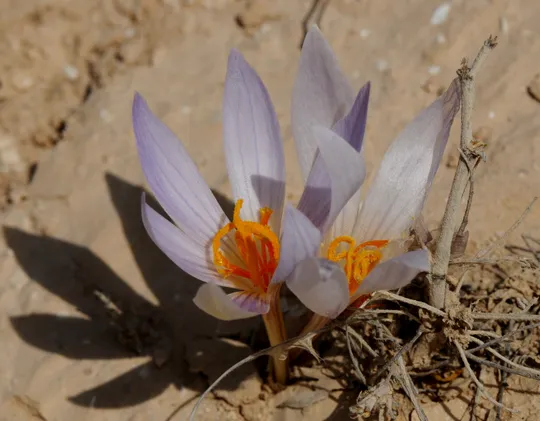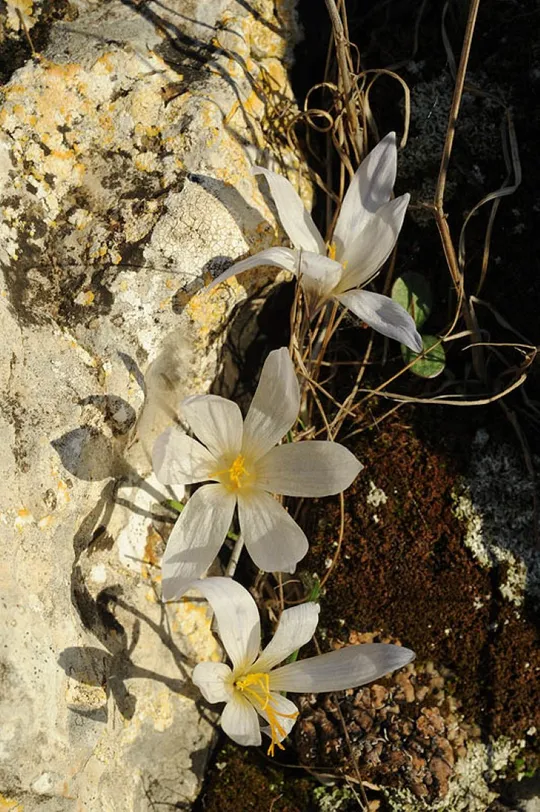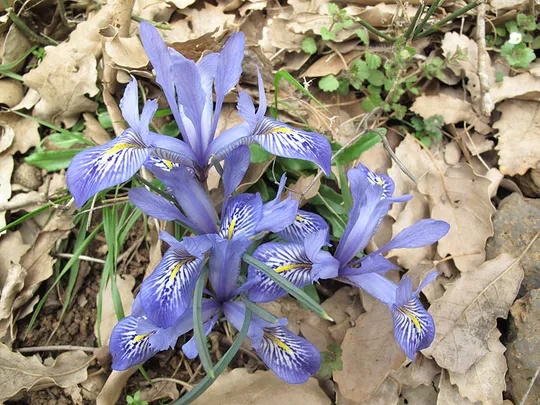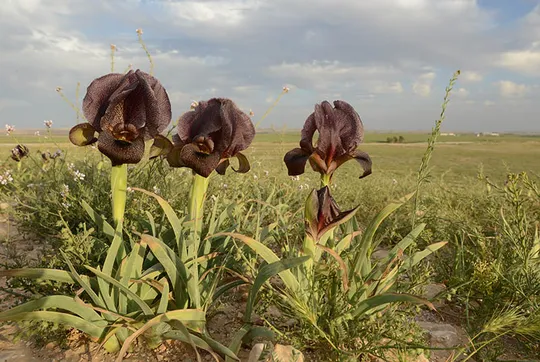Crocus aleppicus (coastal populations)
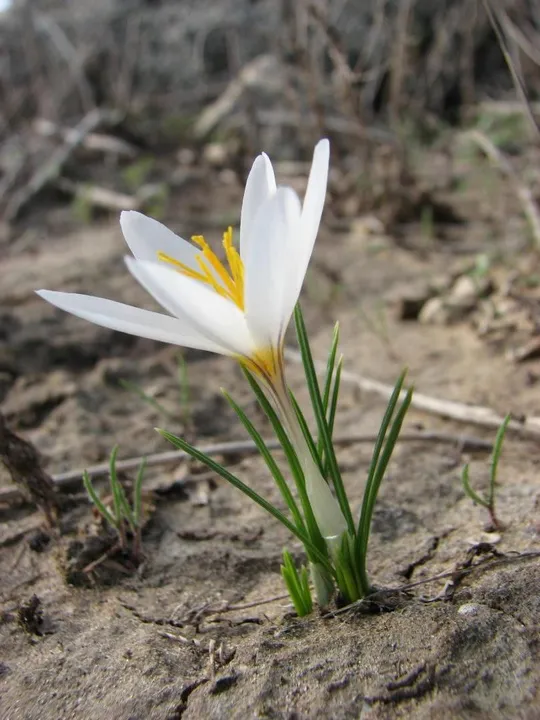
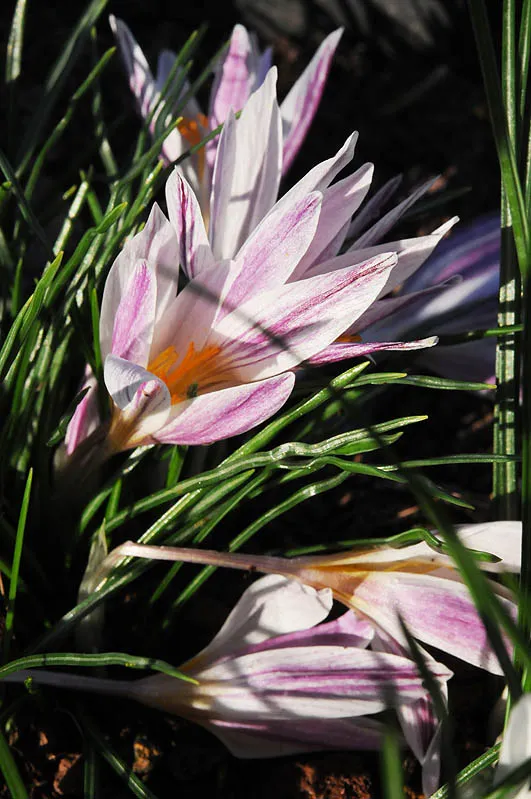
Crocus aleppicus grows in two
regions: the Carmel Coast and the Sharon, on 13 sites. In the Carmel Coast, it
grows in soil pockets on the calcareous
sandstone ridges between HaBonim
and Ma'agan Mikhael and continues to the northern Sharon, to the Bet Hanania
area.
Habitat:
Mediterranean scrubland rich in geophytes on calcareous
sandstone ridges. Crocus aleppicus grows together with many geophytes that include
Narcissus serotinus, Colchicum stevenii, Scilla autumnalis, Muscari parviflorum
and Iris palaestina.
Crocus aleppicus is a taxon endemic to Israel, currently known only from the Carmel Coast and
the northern Sharon.
Crocus aleppicus is a variable species found in the Mediterranean region and on its edges in western Syria from Halab (Aleppo) southwards to the Anti-Lebanon and Hermon mountains. There are large populations on the basalt ridges of the Golan Heights and the eastern Upper Galilee. On the coast, it was discovered on the Carmel Coast and in the Sidon area. The species was also recorded from the high areas of Moab and Edom in Jordan. In Ras al-Naqb in Edom the isolated desert population has a characteristic corm covered with many layers that create a tunic along the lower stem and small, exceptionally fragrant flowers. The Carmel Coast population, is presented here as a taxon on its own. The "coastal C. aleppicus", differs from the eastern Galilee and the Golan Heights C. aleppicus, by having individuals with purple flowers similar to C. hermoneus. Mouterde (in the Flora of Syria and Lebanon) considered C. hermoneus-C. aleppicus-C. damascenus a group of extremely close species, and tended to combine them into one species. He also found and described the population of C. aleppicus in the Sidon region on the Lebanese coast. This description of the plants is similar to the population of the Carmel Coast, although they were not actually compared. The distribution pattern of the coastal C. aleppicus is reminiscent of Romulea phoenicia (an endemic species found to the coastal ridges from Sidon to Carmel. This group creates a pattern of local endemism, specific to southern Lebanon and northern Israel in the Mediterranean region. In the same way as C. aleppicus that was discovered in Edom, Romulea petraea, which is extremely close to R. Phoenicia, was described from Edom.
C. veneris is common in Cyprus, and is the most common crocus on the island, as well as being the closest and most similar species to C. aleppicus (Mathew, 1982). It differs from it by the small number of leaves (2-4 vs. 5-9 in C. aleppicus) and by the corm layers that are thin-fibrous (compared to fibrous and coarse in C. aleppicus). C. veneris is a modest and more delicate plant than the coastal C. aleppicus – it has smaller flowers and narrower leaves and is reminiscent of C. aleppicus from Edom. We believe that the coastal C. aleppicus is an intermediate taxon between C. aleppicus and C. veneris. Genetic research and a quantitative morphological survey of the population is needed to reach conclusions regarding the status of the coastal C. aleppicus and the species close to it. Clearly, these are special populations that indicate the existence of an endemic coastal taxon with a local distribution.
Crocus aleppicus in the broad sense is close and similar to C. hyemalis, the most common crocus in Israel. Both have characteristic stigmas that split into a number of capillary lobes, but whereas the anthers of C. hyemalis are black, the anthers of C. aleppicus are yellow. Rarely, mutant plants with yellow anthers are found in C. hyemalis populations. Crocus aleppicus replaces C. hyemalis in the Golan Heights, in Syria, in Lebanon and in the northeastern Galilee. Wadi Dishon is the approximate boundary between C. hyemalis and C. aleppicus – C. aleppicus grows north of it and to the east and south of it and C. hyemalis grows to the west (Feinbrun and Shmida, 1978). This geographical-taxonomical arrangement is "broken" by the Carmel Coast C. aleppicus population that grows as an enclave within the C. hyemalis populations.
This particular
subspecies is limited only to one region and to the edges of an additional
region in Israel, in a limited geographical area on the Carmel Coast – an area
sensitive to development. The coastal Crocus aleppicus
is protected in Israel by law. Its local threat is equivalent to its global threat
as the subspecies is endemic to Israel.
Crocus aleppicus
should be monitored on an annual and long-term basis. Backup populations should
be cultivated in botanical gardens.
Crocus aleppicus is a taxon endemic to Israel, currently known only from the Carmel Coast and
the northern Sharon.
Crocus aleppicus is a geophyte whose taxonomic status is that of a subspecies. It is endemic
to a limited area of the
Carmel Coast and grows in a habitat that is extremely sensitive to development.
Feinbrun, N. and A. Shmida, 1978. A review in the genus Crocus in Israel and neighbng countries. Isr. J. Bot. 26: 172-189.
Mathew, B. 1982. The Crocus. Batsford. pp. 103-105.
Current Occupancy Map
| 1000 squre meter pixel | 5000 squre meter pixel | 10000 squre meter pixel | |
|---|---|---|---|
| number of observations | 0 | 0 | 0 |
| in total pixels | 0 | 0 | 0 |
| Family | Iridaceae |
| Classification | On the endangered species list |
| Ecosystem | Mediterranean |
| Chorotype | Eastern Mediterranean |
| Conservation Site | Kurkar (sandstone) in Ma'agan Mikhael |
| Rarity |
1
3
6
|
|---|---|
| Vulnerability |
0
2
4
|
| Attractiveness |
0
0
4
|
| Endemism |
0
3
4
|
| Red number |
1
4.2
10
|
| Peripherality | 0 |
| IUCN category | DD EW EX LC CR EN VU NT |
| Threat Definition according to the red book | Endangered |
 Participated:
Participated:
